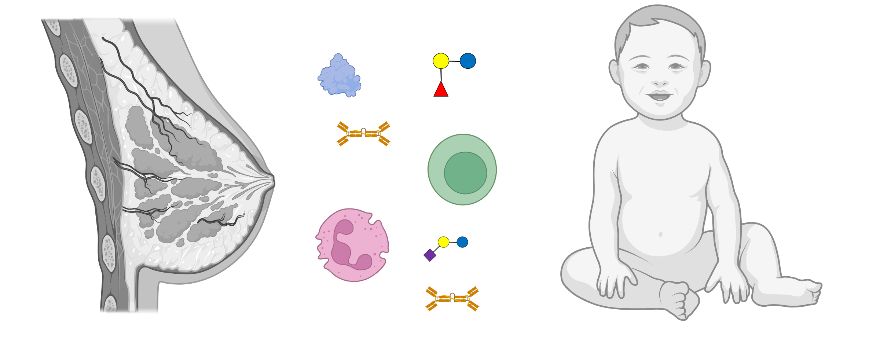This publication is a brief introduction to how breastmilk helps keep babies healthy and helps them recover faster when they get sick. This publication is meant to provide information about breastfeeding benefits for babies.
What is in breastmilk that helps keep babies healthy?
Breastmilk contains many things not found in formula, including antibodies and high levels of human milk oligosaccharides. Antibodies are Y-shaped proteins that bind to the microbes that can make someone sick. Mothers produce antibodies to protect themselves against getting sick with the same pathogen twice; these antibodies are always present in breastmilk to help keep the baby healthy if they encounter a pathogen the mother has already recovered from (Nathavitharana et al. 1994; Sadeharju et al. 2007). This works because the antibodies can bind to the pathogen, which means the pathogen cannot infect the baby’s cells. In addition to antibodies, human milk contains immune cells. These immune cells can enter the infant’s blood and help to fight off any pathogens the infant is exposed to (Witkowska-Zimmy and Kaminska-El-Hassan 2017).
Another compound in breastmilk that helps keep babies healthy is lactoferrin. Lactoferrin is a protein that binds iron. It has antiviral activity, which means it helps keep babies from getting sick with a virus (Wakabayashi et al. 2014). This may include SARS-CoV-2, the virus that causes COVID (Kell et al. 2020).
Human breastmilk also contains human milk oligosaccharides (HMOs). HMOs are specialized sugars that beneficial bacteria use to grow. When growing, the beneficial bacteria change the HMOs into short-chain fatty acids. As many pathogens do not grow well in the presence of short-chain fatty acids, this helps to keep the baby healthy (Langfeld et al. 2021). HMOs can also prevent pathogens from infecting cells (Newburg et al. 2005).

Credit: Created with Biorender.com
How does breastmilk change when babies get sick?
Breastmilk changes in composition when babies are sick, especially when babies are nursed at the breast. This happens because when babies nurse at the breast, mothers are exposed to antigens from whatever is making the baby sick. Antigens are proteins that the immune system targets with antibodies to fight off an infection. So when mothers are exposed to antigens from their sick baby, they start to make antibodies that specifically target the pathogen making the baby sick (Lokossou et al. 2022). When babies are sick, the number of immune cells present in milk increases as well (Riskin et al. 2012).
References
Kell, D. B., E. L. Heyden, and E. Pretorius. 2020. "The Biology of Lactoferrin, an Iron-Binding Protein That Can Help Defend against Viruses and Bacteria." Frontiers in Immunology 11: 550441. https://doi.org/10.3389/fimmu.2020.01221
Langfeld, L. Q., K. Du, S. Bereswill, and M. M. Heimesaat. 2021. "A Review of the Antimicrobial and Immune-Modulatory Properties of the Gut Microbiota-Derived Short Chain Fatty Acid Propionate–What is new?" European Journal of Microbiology and Immunology 11 (2): 50-56. https://doi.org/10.1556/1886.2021.00005
Lokossou, G. A. G., L. Kouakanou, A. Schumacher, and A. C. Zenclussen. 2022. "Human Breast Milk: From Food to Active Immune Response With Disease Protection in Infants and Mothers." Frontiers in Immunology 13: 849012. https://doi.org/10.3389/fimmu.2022.849012
Nathavitharana, K. A., D. Catty, and A. S. McNeish. 1994. "IgA Antibodies in Human Milk: Epidemiological Markers of Previous Infections?" Archives of Disease in Childhood - Fetal and Neonatal Edition 71 (3): F192–F197. https://doi.org/10.1136/fn.71.3.F192
Newburg, D. S., G. M. Ruiz-Palacios, and A. L. Morrow. 2005. "Human milk glycans protect infants against enteric pathogens." Annual Review of Nutrition 25: 37–58. https://doi.org/10.1146/annurev.nutr.25.050304.092553
Riskin, A., M. Almog, R. Peri, K. Halasz, I. Srugo, and A. Kessel. 2012. "Changes in Immunomodulatory Constituents of Human Milk in Response to Active Infection in the Nursing Infant." Pediatric Research 71 (2): 220–225. https://doi.org/10.1038/pr.2011.34
Sadeharju, K., M. Knip, S. M. Virtanen, E. Savilahti, S. Tauriainen, P. Koskela, H. K. Åkerblom, H. Hyoty, and the Finish TRIGR Study Group. 2007. "Maternal antibodies in breast milk protect the child from enterovirus infections." Pediatrics 119 (5): 941–946. https://doi.org/10.1542/peds.2006-0780
Wakabayashi, H., H. Oda, K. Yamauchi, and F. Abe. 2014. "Lactoferrin for Prevention of Common Viral Infections." Journal of Infection and Chemotherapy 20 (11): 666–671. https://doi.org/10.1016/j.jiac.2014.08.003
Witkowska-Zimny, M., and E. Kaminska-El-Hassan. 2017. "Cells of Human Breast Milk." Cellular and Molecular Biology Letters 22: 11. https://doi.org/10.1186/s11658-017-0042-4